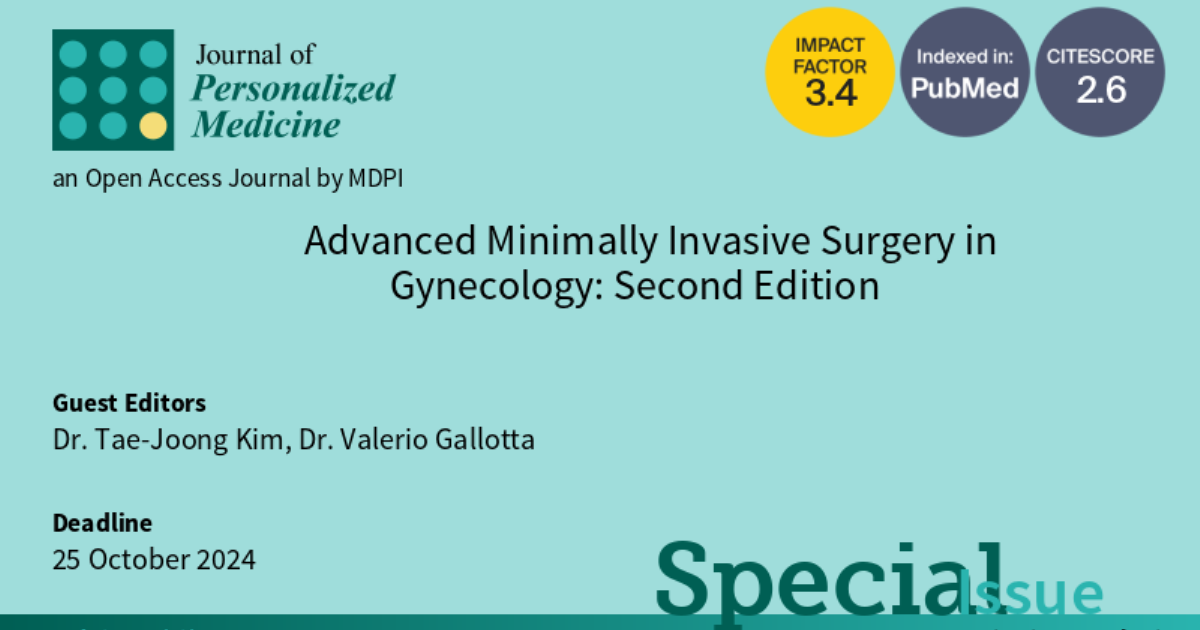Advanced Minimally Invasive Surgery in Gynecology: Second Edition
A special issue of Journal of Personalized Medicine (ISSN 2075-4426). This special issue belongs to the section "Methodology, Drug and Device Discovery".
Deadline for manuscript submissions: 25 October 2024 | Viewed by 802

Special Issue Editors
Interests: gynecologic cancers; single-port surgery; natural orifice transluminal endoscopic surgery (NOTES); robotic surgery; image-guided surgery; lymphatic mapping; innovative techniques
Special Issues, Collections and Topics in MDPI journals
Interests: cervical cancer; minimally invasive surgery; fertility sparing treatments; translational medicine; sentinel lymph node concept; gynecological cancers
Special Issues, Collections and Topics in MDPI journals
Special Issue Information
Dear Colleagues,
Since the introduction of laparoscopy, remarkable achievements have been made in the field of gynecologic surgery, the impact of which cannot be overemphasized.
This Special Issue of the Journal of Personalized Medicine, ‘Advanced Minimally Invasive Surgery in Gynecology Second Edition’, aims to collate papers on the most advanced and cutting-edge innovations in the landscape of gynecologic surgery. We cordially invite submissions of manuscripts that reflect both practical and technical innovations and expertise in this field. Potential topics include, but not limited to, the following:
- Minimally invasive laparoscopic surgery;
- Ultra-minimally invasive laparoscopic surgery;
- Single-incision laparoscopic surgery (SILS);
- Robot-assisted laparoscopic surgery;
- Reduced port surgery;
- Vaginal natural orifice transluminal endoscopic surgery (vNOTES);
- 3D laparoscopic surgery;
- Sentinel lymph node mapping and biopsy;
- Tactile sensing laparoscopic surgery;
- Augmented reality (AR) visualization laparoscopic surgery;
- Intraoperative laparoscopic ultrasound.
Dr. Tae-Joong Kim
Dr. Valerio Gallotta
Guest Editors
Manuscript Submission Information
Manuscripts should be submitted online at www.mdpi.com by registering and logging in to this website. Once you are registered, click here to go to the submission form. Manuscripts can be submitted until the deadline. All submissions that pass pre-check are peer-reviewed. Accepted papers will be published continuously in the journal (as soon as accepted) and will be listed together on the special issue website. Research articles, review articles as well as short communications are invited. For planned papers, a title and short abstract (about 100 words) can be sent to the Editorial Office for announcement on this website.
Submitted manuscripts should not have been published previously, nor be under consideration for publication elsewhere (except conference proceedings papers). All manuscripts are thoroughly refereed through a single-blind peer-review process. A guide for authors and other relevant information for submission of manuscripts is available on the Instructions for Authors page. Journal of Personalized Medicine is an international peer-reviewed open access monthly journal published by MDPI.
Please visit the Instructions for Authors page before submitting a manuscript. The Article Processing Charge (APC) for publication in this open access journal is 2600 CHF (Swiss Francs). Submitted papers should be well formatted and use good English. Authors may use MDPI's English editing service prior to publication or during author revisions.
Keywords
- minimally invasive laparoscopic surgery
- ultra-minimally invasive laparoscopic surgery
- single-incision laparoscopic surgery (SILS)
- robot-assisted laparoscopic surgery
- reduced port surgery
- vaginal natural orifice transluminal endoscopic surgery (vNOTES)
- 3D laparoscopic surgery
- sentinel lymph node mapping and biopsy
- tactile sensing laparoscopic surgery
- augmented reality (AR) visualization laparoscopic surgery
- laparoscopic ultrasound






